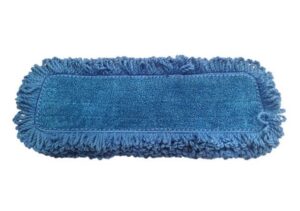 Microfiber mops have the power to transform any cleaning routine, boosting both its efficiency and speed beyond anything inferior equipment is capable of.
Microfiber mops have the power to transform any cleaning routine, boosting both its efficiency and speed beyond anything inferior equipment is capable of.
One of microfiber’s key benefits is its incredible adhesive qualities: consisting of thousands of tiny fibers, this material can pick up the most minute dirt and dust particles. This is so powerful cleaning staff are able to use just water instead of chemical-based products and still leave surfaces remarkably clean.
However, while microfiber mops boast an impressive durability, the head has to be replaced eventually. How do you know when the time’s right?
Every Job is Different
The right time to switch your microfiber mop head varies depending on its application.
For example, a hospital’s cleaning staff will be required to wipe floors (coated with blood, chemicals, and other residues) vigorously and often. There is a shocking variety of healthcare-associated infections (HAIs) which can become a real risk in hospitals with poor cleaning standards.
In an environment like this, the sheer amount of people passing through, and the bacteria, demands a high standard of cleaning on a daily basis. As a result, mop heads will need to be removed and washed regularly.
In another setting, such as an office with a small team, there may be less demand for such a strict cleaning routine. Here, microfiber mop heads can be laundered with less frequency.
Microfiber mop heads can typically withstand between 500 and 1000 washes. After this, they will start to lose their efficiency and absorb less water.
Fortunately, switching your mop head is quick and easy, and replacements are very affordable.
How Should You Launder Your Microfiber Mops?
Microfiber mops are designed to provide you with the most efficient clean possible, and laundering them properly will help you get the most out of their extensive lifecycle.
First and foremost, you should never wash microfiber with any materials which are heavy with lint: given its strong adhesive power, microfiber will attract lint and possibly need laundering again as soon as it leaves the machine.
You should also use a low temperature when washing microfiber mop heads, and never use fabric softener, as this will clog the material’s open spaces. As a result, your mop heads may fail to actually clean as efficiently as they should, even if they should still have a lot more washes in them.
You can wash microfiber mop heads by hand, if necessary, using very warm water. You should also air-dry them, as microfiber dries with impressive speed, ready for use earlier than you might expect.
You should also avoid using bleach when washing microfiber mop heads, and ideally launder them alongside other microfiber materials (to avoid the aforementioned unwanted attraction of lint or other fibers).
Following these steps will ensure your microfiber cleaning products provide maximum value for money.
At Texas Microfiber, we can help you find the microfiber cloths, mops, and more for the highest quality of cleaning. Contact our team if you want to know more!

Comments are closed